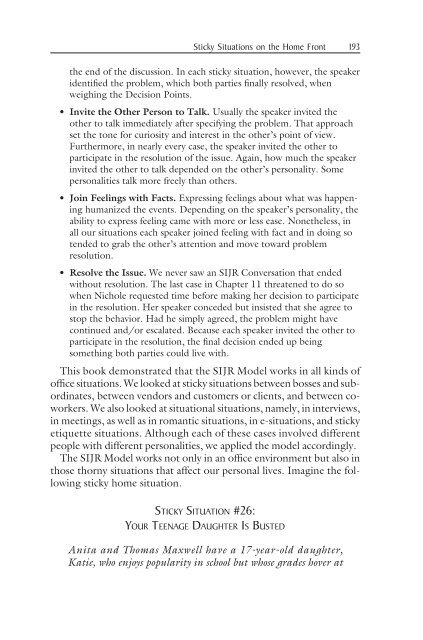Managing Sticky Situations at Work
Managing Sticky Situations at Work
Managing Sticky Situations at Work
You also want an ePaper? Increase the reach of your titles
YUMPU automatically turns print PDFs into web optimized ePapers that Google loves.
<strong>Sticky</strong> <strong>Situ<strong>at</strong>ions</strong> on the Home Front 193the end of the discussion. In each sticky situ<strong>at</strong>ion, however, the speakeridentified the problem, which both parties finally resolved, whenweighing the Decision Points.• Invite the Other Person to Talk. Usually the speaker invited theother to talk immedi<strong>at</strong>ely after specifying the problem. Th<strong>at</strong> approachset the tone for curiosity and interest in the other’s point of view.Furthermore, in nearly every case, the speaker invited the other toparticip<strong>at</strong>e in the resolution of the issue. Again, how much the speakerinvited the other to talk depended on the other’s personality. Somepersonalities talk more freely than others.• Join Feelings with Facts. Expressing feelings about wh<strong>at</strong> was happeninghumanized the events. Depending on the speaker’s personality, theability to express feeling came with more or less ease. Nonetheless, inall our situ<strong>at</strong>ions each speaker joined feeling with fact and in doing sotended to grab the other’s <strong>at</strong>tention and move toward problemresolution.• Resolve the Issue. We never saw an SIJR Convers<strong>at</strong>ion th<strong>at</strong> endedwithout resolution. The last case in Chapter 11 thre<strong>at</strong>ened to do sowhen Nichole requested time before making her decision to particip<strong>at</strong>ein the resolution. Her speaker conceded but insisted th<strong>at</strong> she agree tostop the behavior. Had he simply agreed, the problem might havecontinued and/or escal<strong>at</strong>ed. Because each speaker invited the other toparticip<strong>at</strong>e in the resolution, the final decision ended up beingsomething both parties could live with.This book demonstr<strong>at</strong>ed th<strong>at</strong> the SIJR Model works in all kinds ofoffice situ<strong>at</strong>ions. We looked <strong>at</strong> sticky situ<strong>at</strong>ions between bosses and subordin<strong>at</strong>es,between vendors and customers or clients, and between coworkers.We also looked <strong>at</strong> situ<strong>at</strong>ional situ<strong>at</strong>ions, namely, in interviews,in meetings, as well as in romantic situ<strong>at</strong>ions, in e-situ<strong>at</strong>ions, and stickyetiquette situ<strong>at</strong>ions. Although each of these cases involved differentpeople with different personalities, we applied the model accordingly.The SIJR Model works not only in an office environment but also inthose thorny situ<strong>at</strong>ions th<strong>at</strong> affect our personal lives. Imagine the followingsticky home situ<strong>at</strong>ion.STICKY SITUATION #26:YOUR TEENAGE DAUGHTER IS BUSTEDAnita and Thomas Maxwell have a 17-year-old daughter,K<strong>at</strong>ie, who enjoys popularity in school but whose grades hover <strong>at</strong>















